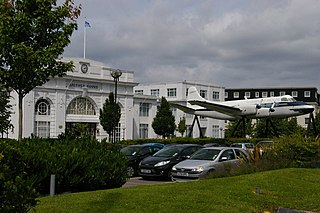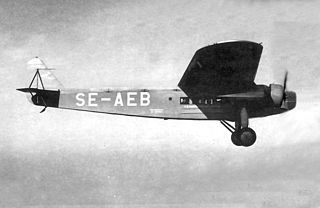
The Tenerife airport disaster occurred on 27 March 1977, when two Boeing 747 passenger jets collided on the runway at Los Rodeos Airport on the Spanish island of Tenerife. The collision occurred when KLM Flight 4805 initiated its takeoff run during dense fog while Pan Am Flight 1736 was still on the runway. The impact and resulting fire killed all on board KLM Flight 4805 and most of the occupants of Pan Am Flight 1736, with only 61 survivors in the front section of the aircraft. With a total of 583 fatalities, the disaster is the deadliest accident in aviation history.

Croydon Airport was the UK's only international airport during the interwar period. It opened in 1920, located near Croydon, then part of Surrey. Built in a Neoclassical style, it was developed as Britain's main airport, handling more cargo, mail, and passengers than any other UK airport at the time. Innovations at the site included the world's first air traffic control and the first airport terminal. During World War II the airport was named RAF Croydon as its role changed to that of a fighter airfield during the Battle of Britain; and in 1943 RAF Transport Command was founded at the site, which used the airport to transport thousands of troops into and out of Europe.

Tenerife North–Ciudad de La Laguna Airport, formerly Los Rodeos Airport, is the smaller of the two international airports on the island of Tenerife, Spain. It is located in San Cristóbal de La Laguna, 11 km (7 mi) by road from Santa Cruz and at an elevation of 633 metres (2,077 ft). It handled 3,717,944 passengers in 2012. Combined with Tenerife South Airport, the island gathers the highest passenger movement of all the Canary Islands, with 12,248,673 passengers, surpassing Gran Canaria Airport. Today TFN is an inter-island hub connecting all seven of the main Canary Islands with connections to the Iberian Peninsula and Europe.

The McDonnell Douglas DC-9 is an American five-abreast, single-aisle aircraft designed by the Douglas Aircraft Company. It was initially produced as the Douglas DC-9 prior to August 1967, after which point the company had merged with McDonnell Aircraft to become McDonnell Douglas. Following the introduction of its first jetliner, the high-capacity DC-8, in 1959, Douglas was interested in producing an aircraft suited to smaller routes. As early as 1958, design studies were conducted; approval for the DC-9, a smaller all-new jetliner, came on April 8, 1963. The DC-9-10 first flew on February 25, 1965, and gained its type certificate on November 23, to enter service with Delta Air Lines on December 8.

Jacob Louis Veldhuyzen van Zanten was a Dutch aircraft captain and flight instructor. He was captain of the KLM Flight 4805 and died in the Tenerife airport disaster, the deadliest accident in aviation history. He was KLM's chief instructor and commonly appeared on advertising.
Air Union was a French airline established on 1 January 1923, as the result of a merger between the airlines Compagnie des Messageries Aériennes and Compagnie des Grands Express Aériens. Air Union was merged with four other French airlines to become Air France on 7 October 1933.

The 1990 Wayne County Airport runway collision involved the collision of two Northwest Airlines jetliners at Detroit Metropolitan Wayne County Airport on December 3, 1990. Flight 1482, a scheduled Douglas DC-9-14 operating from Detroit to Pittsburgh International Airport, taxied by mistake onto an active runway in dense fog and was hit by a departing Boeing 727 operating as Flight 299 to Memphis International Airport. One member of the crew and seven passengers of the DC-9 were killed.

The Madrid runway disaster was on 7 December 1983 when a departing Iberia Boeing 727 struck an Aviaco McDonnell Douglas DC-9 at Madrid-Barajas Airport, causing the deaths of 93 passengers and crew.

The 1950 Heathrow BEA Vickers Viking crash occurred on 31 October 1950 when a Vickers Viking operated by British European Airways (BEA) crashed at London Airport in heavy fog. The aircraft was on a scheduled flight between Paris and London's Northolt airport and 28 of the 30 passengers and crew on board were killed.

The 1927 KLM Fokker F.VIII crash happened on 22 August 1927 when Fokker F.VIII H-NADU of KLM crashed at Underriver, Kent, following structural failure of the tailfin or rudder. The aircraft was operating an international scheduled flight from Croydon, Surrey, to Waalhaven Airport, Rotterdam, the Netherlands. One of the two crew was killed and eight people were injured.

The 1929 Imperial Airways Handley Page W.10 crash happened on 17 June 1929 when Handley Page W.10 G-EBMT suffered an engine failure and subsequently ditched in the English Channel off Dungeness with the loss of seven lives. The aircraft was operating an international scheduled flight from Croydon to Le Bourget Airport, Paris, France.

The Douglas DC-2 is a 14-passenger, twin-engined airliner that was produced by the American company Douglas Aircraft Company starting in 1934. It competed with the Boeing 247. In 1935, Douglas produced a larger version called the DC-3, which became one of the most successful aircraft in history.

The 1929 Luft Hansa Junkers G.24 crash occurred on 6 November 1929 when a Junkers G 24 of Luft Hansa crashed at Godstone, Surrey, United Kingdom while on an international scheduled flight from Croydon, Surrey, United Kingdom to Amsterdam-Schiphol Municipal Airport, Amsterdam, Netherlands. Of the eight people on board, Glen Kidston was the only survivor.

The 1924 Imperial Airways de Havilland DH.34 crash occurred on 24 December 1924 when de Havilland DH.34 G-EBBX of Imperial Airways crashed at Purley, Surrey, United Kingdom killing all eight people on board. The aircraft was operating a scheduled international flight from Croydon, Surrey, to Paris, France. It was the first fatal accident suffered by Imperial Airways and led to the first public inquiry into a civil aviation accident in the United Kingdom. As a result of issues brought up during the inquiry, Croydon Airport was expanded, absorbing most of Beddington Aerodrome.

The 1946 KLM Douglas C-47 Amsterdam accident was the crash of a KLM Royal Dutch Airlines flight from London to Amsterdam on 14 November 1946. The accident occurred as the aircraft was attempting to land at Amsterdam's airport in poor weather. All 26 passengers and crew on board were killed.

On 23 December 1983, Korean Air Lines Flight 084 (KAL084), a McDonnell Douglas DC-10-30CF performing a cargo flight, collided during its takeoff roll with SouthCentral Air Flight 59 (SCA59), a Piper PA-31-350, on runway 06L/24R at Anchorage International Airport, as a result of the KAL084 flight crew becoming disoriented while taxiing in dense fog and attempting to take off on the wrong runway. Both aircraft were destroyed, but no fatalities resulted.















